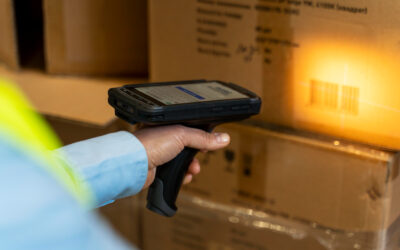
There’s nothing worse than spending money on something that isn’t being used. When it comes to IT hardware inventory management, it’s no different.
There are many pieces of software out there that can help you with your IT hardware inventory management. If you’re looking for easy-to-use software, check out itemit.
However, before you roll out your new software system, it’s worth checking that you have fully streamlined your process. After all, the quality of a system relies heavily on the processes and data that go into it.
IT hardware inventory management is designed to make your company’s processes more efficient. Here are our 7 top tips to help you ensure that your PC and hardware management is as pain-free as it can be!
What is IT Inventory Management?
IT inventory management is a process of systematic collection, analysis, and documentation of all information about computer equipment, software, network resources, and other elements of an organisation’s IT infrastructure. This process is based on the objective of fully and accurately accounting all resources, their characteristics and relationships, which allows the organisation to manage its IT assets better and ensure their security and efficiency.
Management of IT Hardware Inventory

Important parts of managing IT hardware inventory:
- Asset Tracking involves maintaining a comprehensive log of every hardware asset, noting their whereabouts, condition, and possession.
- Lifecycle Management involves monitoring the entire lifespan of IT hardware, from procurement to disposal, which includes maintenance, upgrades, and repairs.
- Checking compliance and auditing to guarantee the organisation follows regulations and produces precise reports for audits.
- Cost Management. Managing expenses by preventing unnecessary purchases, maximising asset usage, and preparing for future hardware requirements.
- Managing risks. Reducing the chance of hardware failures, data breaches, and other vulnerabilities linked to IT.
- Optimising Inventory. Finding the right balance in inventory levels to meet demand efficiently without excess or shortage, guaranteeing timely availability of necessary equipment.
Advantages of Efficient Management of IT Hardware Inventory:
- Increased effectiveness: Enhances efficiency by allowing fast retrieval of asset data.
- Cost Savings: Decreases unneeded spending and prolongs the lifespan of current equipment.
- Increased Security: Aids in monitoring and protecting important equipment, minimising the possibility of data leaks.
- Improved Decision-Making: Offers important information on asset utilisation and requirements, assisting in budgeting and resource distribution.
Managing IT hardware inventory is very important to maintain a dependable and protected IT system, guaranteeing that the organisation’s technology foundation efficiently serves its business functions.
Difference Between Computer Hardware and Software Inventory
Managing hardware and software inventory is essential for IT asset management, as it involves different types of assets within the company.
Software inventory management centers around overseeing and managing all software resources like applications, licenses, and subscriptions utilised within the organisation. This involves tracking software usage, guaranteeing adherence to licensing agreements, and handling software updates and renewals to mitigate legal and operational risks.
The primary distinction between these two categories lies in the types of assets SMEs manage.
Hardware inventory requires maintenance due to its limited lifespan, while software inventory may have varying licensing terms, usage rights, and upgrade schedules. Hardware assets management can be simply achieved through serial numbers and physical inspections while overseeing programs, which also involves overseeing license usage, monitoring usage, and ensuring compliance.
Effective management of equipment and PC inventory software is essential for optimising IT resources, staying compliant, and cutting costs. Nevertheless, every form of asset management demands distinct tactics and instruments based on its individual traits.
Disclosing IT Inventory Management Software

Specialised software for managing computer hardware inventory is designed to assist businesses in monitoring their physical IT assets. These assets consist of servers, computers, networking equipment, peripherals, and other essential hardware devices for a company’s functioning. The software offers a centralised platform for overseeing these assets, guaranteeing that businesses are aware of their location, contents, and usage.
Key Features of Computer Inventory System
Asset Tracking is the main function of the software. Businesses can monitor their hardware assets in real-time using this feature. This feature allows you to easily track the whereabouts, status, and condition of every asset, decreasing the possibility of loss or theft.
Automated inventory audits can save time and reduce errors compared to manual auditing of hardware inventory. The process is automated by the software, giving precise and current information on your assets. Regular audits help ensure adherence and promptly detect any discrepancies.
IT hardware undergoes different stages throughout its lifecycle, starting with acquisition and ending with disposal. The software controls every stage of every asset’s life, including purchase, utilisation, upkeep, and disposal. This guarantees that you optimise the worth of your assets with minimal downtime.
Understanding how your hardware is performing and being used is essential for making informed decisions in reporting and analytics. The software offers thorough reports and analysis, providing information on asset productivity, usage trends, and possible ways to save money.
Integration with other systems is possible as IT hardware inventory management software can smoothly connect with IT service management (ITSM) tools, procurement systems, and financial software. This integration guarantees that your IT procedures are coordinated and that information moves seamlessly throughout your company.
The software can be set up to issue alerts and notifications for different occurrences, like warranty expiration, maintenance plans, or asset outages. This proactive method prevents disturbances and guarantees that your hardware remains in excellent condition at all times.
Ways to Manage Inventory of IT Hardware

Efficient management of hardware inventory requires the use of various methods and best practices, which are supported by the software.
Using barcodes or RFID tags to tag assets is a widely used way to keep track of hardware. The software is able to scan and update asset information instantly, delivering precise data on the location and condition of assets.
Authorised personnel have access to all asset information stored in a single database. This approach guarantees that there is only one accurate source for all hardware-related information, decreasing the likelihood of mistakes and discrepancies.
Regularly auditing and reconciling inventory data with physical assets is crucial for maintaining accuracy. The software streamlines these audits, simplifying the process of identifying and correcting any discrepancies.
The software enables you to specify user roles and permissions in order to protect data security. By doing this, only approved individuals are able to reach or alter asset details, decreasing the chance of unauthorised adjustments.
Documentation and record-keeping are crucial for the effective management of IT hardware. The software assists in managing thorough records for every asset, which includes purchase specifics, warranty details, and maintenance history.
What Do You Gain With Computer Inventory Software
The importance of computer inventory software cannot be highlighted enough. Here is the reason why it is crucial for your company:
Cost Reduction: The software offers insight into your hardware assets, helping you optimise asset utilisation and decrease unnecessary purchases. Additionally, it helps avoid financial losses caused by theft or misplacing items, leading to more savings.
Enhanced effectiveness: By automating tracking, auditing, and reporting, the software does away with manual procedures, saving time and decreasing error risks. This results in improved operational effectiveness.
Improved Security: Effective management of assets ensures that all important hardware is properly tracked, minimising the chance of data breaches or unauthorised entry. The software also aids in overseeing device security by providing updates and patches on time.
Adherence and Responsibility: Many sectors require businesses to follow particular guidelines concerning asset management. The software aids in maintaining adherence by offering precise records and audit trails, guaranteeing that your business complies with all regulatory requirements.
Proactive maintenance is made possible by the software’s alerting and notification capabilities, which help minimise the chances of unforeseen breakdowns and keep your IT infrastructure dependable.
And now that we’ve gotten more familiar with the topic, broken down the main methods, types and specifics of IT inventory, we can move on to some very useful tips that will help you manage your IT Hardware effectively and easily.
1. Know What You Have

First things first. It may seem obvious, but knowing what PCs, computers and hardware you have is critical. We speak to businesses every day that are struggling to rectify the fact that they don’t know what assets they have.
If you have an out-of-date list of assets, it may be worth starting with that to establish which assets are still in use and add any new ones to your IT asset inventory list. However, if your data is very old, you may find it more efficient to start from scratch and perform an audit of all hardware that’s in circulation.
2. Tag Your IT Hardware
IT hardware often includes assets that move around a lot. This may be mobile devices, laptop inventory for working from home and monitors and computers that can be moved from office to office depending on where new recruits are being based. To ensure your IT hardware inventory remains as efficient as possible, it’s paramount that you start tracking the movement of these assets.
We recommend using QR code asset tags to easily track the location of your assets. Once each asset is tagged, it can simply be scanned to be uniquely identified. A quick scan of the tag from a smartphone and the GPS location on your phone will update where your assets were last seen and who had them last.
3. Add Plenty of Information
The information you’ll want to add will differ from asset to asset. However, there are many patterns when it comes to IT hardware inventory management.
IT assets hold data, so information related to usage is essential for GDPR compliance. Also, add warranty expiry dates, PAT testing dates, and user manuals. This way, everything you may need to know about an asset is easily accessible.
4. Assign Hardware to Colleagues
Whether you’re onboarding new colleagues or just want to record which assets have already been distributed to the team, it’s important to know who’s responsible for which hardware. If you’re looking for a quick way to assign assets to users (particularly helpful for your onboarding process), check out the itemit’s Assigning feature to see how easy this is.
IT hardware inventory management is most efficient when you know who is responsible for each asset, making it easier to address replacements or maintenance.
5. Track All Maintenance
As the saying goes: “Technology is great. When it works.” Eventually, your IT hardware will need maintenance and inspections.
This may be routine PAT tests, or it could be reactive maintenance should something break. Either way, it is essential that you track all maintenance related to your IT assets. This will reduce asset downtime significantly, but also helps with the next tip.
6. Use History as an Indicator of Hardware Performance
Without IT hardware inventory management, you won’t have visibility into how your assets are performing. But with a good IT hardware management system in place, you’ll be able to investigate an asset’s historical performance whenever you need to.
For example, whenever an IT asset needs reactive maintenance, you’ll be able to use its history as an indicator as to whether it’s more economical to repair it or replace it.
7. Use the Best IT Hardware Inventory Management Software
Using great IT hardware inventory management software can streamline and automate a lot of these processes.
itemit can do all of this for you, from tracking maintenance and asset movement to assisting with your IT asset register.
To find out more about what itemit can do for you, you can contact the team or fill in the form below to start tracking.

Try itemit
Choose a better way to track
your assets.
Start your free 14-day trial now!
Frequently Asked Questions
How Do You Manage IT Asset Inventory?
Managing IT asset inventory involves tagging each asset with identifiers like barcodes or RFID tags, maintaining a centralised database to track them, and conducting regular audits. Utilising IT Hardware Inventory Management Software can automate these processes, ensuring accurate, real-time information and smooth lifecycle management from procurement to disposal.
What Is Inventory Management and Why Is It Important?
Inventory management IT is the process of tracking and controlling a company’s stock, including raw materials, components, and finished goods. It’s crucial because it helps reduce costs, improve cash flow, and enhance customer satisfaction by ensuring products are available when needed while also minimising waste and storage expenses.
What Is Inventory Management and Its Types?
Inventory management is a systematic approach to handling a company’s stock. The main types include Just-in-Time (JIT), which minimises on-hand inventory; First-In, First-Out (FIFO), which prioritises older inventory; and Last-In, First-Out (LIFO), which uses the newest inventory first. Each type caters to different business strategies.
What Is Just-in-Time Inventory Management, and What Are Its Potential Advantages?
Just-in-Time (JIT) inventory management is a strategy where inventory is ordered only when needed, reducing the amount kept in storage. Its potential advantages include lower storage costs, improved efficiency, better cash flow, reduced risk of obsolescence, and stronger supplier relationships.

Keep Learning
itemit Blog
Tips, guides, industry best practices, and news.
How to Avoid Inventory Mismanagement and Improve Efficiency
Learn how to avoid inventory mismanagement with effective strategies to improve tracking, reduce errors, and ensure efficient stock control for your business
Transform Your Business with itemit: A Guide to Effortless Inventory Management
Discover how itemit simplifies inventory management with real-time tracking, user-friendly features, and seamless mobile access
How Asset Tracking Can Help Prevent Inventory Shortages and Stockouts
Struggling with stockouts? Discover how to manage inventory shortages, prevent disruptions, and optimize your supply chain with expert inventory management tips.



